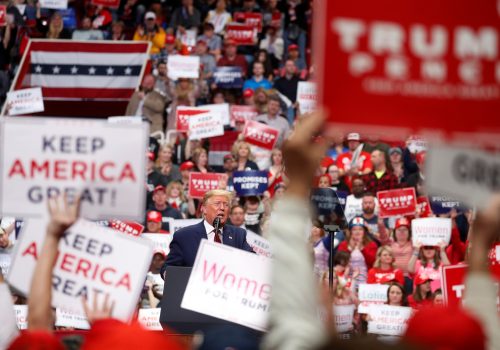Latin America vulnerable to commodity cycle
At the outset of the pandemic, a number of governments in Latin America took swift and aggressive action to curb the virus spread, including travel bans, border controls, quarantines, curfews, states of emergency, and more. Peru’s government, for example, issued an early and well-enforced national lockdown, coupled with an aid package designed to help its citizens weather the resulting economic storm.1Anatoly Kurmanaev, Manuela Andreoni, Letícia Casado, and Mitra Taj, “Latin America’s Outbreaks Now Rival Europe’s. But Its Options Are Worse,” New York Times, May 12, 2020, https://www.nytimes.com/2020/05/12/world/americas/latin-america-virus-death.html?searchResultPosition=2. For a while, these and other measures taken by governments across much of Latin America appeared to spare the region from a full-scale public health crisis.
The full text of the paper is split across the various articles linked below. Readers can browse in any order. To download a PDF version, use the button below.
However, the region’s initially promising situation soon reversed, and Latin America found itself on the global front lines of the pandemic for all the wrong reasons. By late May, new cases in the region had begun to surge past Europe and North America. Several countries faced rapidly mounting number of cases. Johns Hopkins University data showed Brazil leading the region in new cases and mortality, surpassing 584,000 cases and almost 33,000 dead, as of June 4. Brazil’s rapidly increasing case count displaced Russia for second place on the global COVID-19 list. Chile, Ecuador, Mexico, and Peru also faced serious case and (often) mortality numbers.2Data from the COVID-19 Dashboard by the Center for Systems Science and Engineering (CSSE) at Johns Hopkins University (JHU), downloaded June 4, 2020, https://coronavirus.jhu.edu/map.html.
Of the hardest-hit countries in the region, some did not benefit from their initially wise policies. Peru, for instance, fell victim to regional disparities in social distancing behavior combined with high transmission rates in crowded urban slums.3Dan Collyns, “Peru’s Coronavirus Response Was ‘Right on Time’—So Why Isn’t It Working?,” Guardian, May 20, 2020, https://www.theguardian.com/global-development/2020/may/20/peru-coronavirus-lockdown-new-cases.
Many governments were scrutinized for the accuracy of their case rates, even as they began to lay plans to lift economic restrictions. Mexico’s government, to provide a notable example, was accused of seriously undercounting its sick and dead from COVID-19 owing to minimal testing, with the government coming under severe criticism as it began to lift restrictions.4Patrick J. McDonnell, “Mexico City’s Coronavirus Death Toll May Be 3 Times Higher Than Official Count, Report Says,” Los Angeles Times, May 21, 2020, https://www.latimes.com/world-nation/story/2020-05-21/mexico-city-coronavirus-death-toll-may-be-three-times-higher-report-says No country faced a more serious test than did Brazil, owing largely to searing disputes between its populist president, Jair Bolsonaro, and its governors and mayors. Bolsonaro drew widespread criticism at home and abroad not only for his unwillingness to treat the disease as a serious public health threat, but also for his government’s ineffectual and often chaotic response. Brazil’s inability to come to grips with this pandemic contrasts with its often-innovative responses to previous public health scares, including HIV/AIDS and the Zika virus.5Bryan Harris and Andres Schipani, “Brazil Emerges As a Top Global Coronavirus Hotspot,” Financial Times, May 21, 2020, https://www.ft.com/content/065c783e-2402-4c0d-ad40-1b5e38ae96d4; for Brazil’s history of innovative public health responses, see Ernesto Londoño, Manuela Andreoni, and Letícia Casado, “Brazil, Once a Leader, Struggles to Contain Virus Amid Political Turmoil,” New York Times, May 16, 2020, https://www.nytimes.com/2020/05/16/world/americas/virus-brazil-deaths.html.
As a general proposition, Latin America’s structural unpreparedness for the COVID-19 pandemic underlies these storylines. Public health authorities at national and sub-national levels often have limited capacities, state budgets are tight, and the region features many millions of low-income people. As a result, Latin America contains much tinder for pandemic hot spots, as is now being seen for instance in the slums of Lima or São Paulo or among indigenous communities in the Amazon basin, which straddle numerous countries. Added to this mix is a governance credibility gap, as is being shown in Brazil and to some extent in Mexico, and that very much includes Venezuela, which has been struggling with massive economic dislocation and dysfunctional governance, including a non-functioning public health system, for years.6David A. Wemer, “What Latin American Countries Are Doing to Confront Coronavirus,” New Atlanticist, March 23, 2020, https://atlanticcouncil.org/blogs/new-atlanticist/what-latin-american-countries-are-doing-to-confront-coronavirus/.
Many of Latin America’s economies remain overly reliant on the commodity cycle, which in turn means they are severely impacted by global recessions
For the region’s governments and global powers, specifically the United States, the EU, and China, the major questions involve the region’s economic recovery. As with the Middle East’s oil producers, many of Latin America’s economies remain overly reliant on the commodity cycle, which in turn means they are severely impacted by global recessions. All governments face massive pressure to return to normal, given the economic impacts that already are being felt; Argentina, for example, already has had to flirt with a default on its national debt.7Daniel Politi, “Argentina Tries to Escape Default as It Misses Bond Payment,” New York Times, May 22, 2020, https://www.nytimes.com/2020/05/22/world/americas/argentina-default.html?searchResultPosition=2. Although Latin America is not yet a competitive battleground between China and the United States, the degree to which the United States or China helps the region’s countries through their post-pandemic recoveries could determine whether China’s influence increases at the expense of the United States’.
See where US leadership is most vulnerable
Related Content
About the authors
Image: São Paulo, BRAZIL- People are seen walking with protective masks to prevent coronavirus in the streets of São Paulo, Brazil on March 15, 2020.












